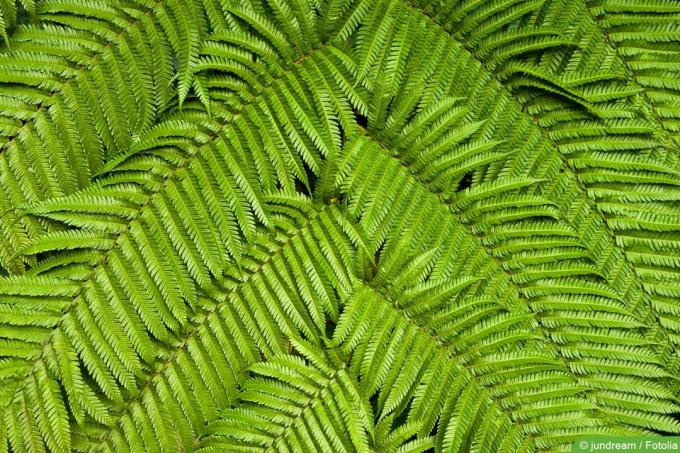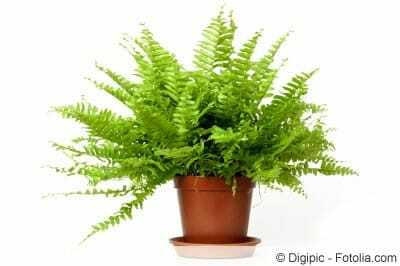

Table of contents
- Characteristics
- Look
- Location
- Floor
- Pour
- Fertilize
- hibernate
- sorts
- frequently asked Questions
These extraordinary creatures are considered the oldest and largest ferns in the world and can grow up to 20 meters high in their home in tropical and subtropical rain forests. in the 19th The first tree ferns came to Europe in the 19th century. In the meantime, the living fossils have also found their way into our domestic gardens and offer fans of ferns the right entry into the world of exotic plants. However, there are a few basic things to keep in mind when keeping and caring for these tropical beauties.
Characteristics
- botanical name: Cyatheales
- Department: Ferns, Vascular Plants
- Genus includes over 620 species
- Use: as a house and container plant
- largest representative: Norfolk tree fern (Cyathea brownii)
- Growth height: up to 30 meters
- Crown diameter: up to five meters
- has a crest of fern fronds on the trunk
- Location: bright, partially shaded to shaded, sheltered from the wind
- Watering: regularly, do not let dry out, spray trunk and fronds
- Fertilizer: Regular liquid fertilizer from April to September
- Hibernation: bright, cool room
Look
Tree ferns are certainly among the more demanding potted plants for garden lovers. The trunk reaches a staggering 30 meters in height in its original home - Norfolk tree fern (Cyathea brownii). The imposing crown with a diameter of up to five meters consists of over 50 filigree fronds, some of which are up to four meters long. At only five centimeters a year, the trunk grows relatively slowly. However, its diameter can be 40 centimeters.
The real Cyatheales has a tuft of fern fronds on its straight trunk, which are multi-pinnate. Pure tree fern families are Dicksonaceae and Cyatheaceae, which are also of commercial importance. The genus Cyatheales includes over 620 species and thus forms the largest group.
Location
In our latitudes, tree ferns can be cultivated as a container or houseplant. As a houseplant, the palm-like creatures should have enough space. Also, a location near a window would be ideal. If the Cyatheales is too dark, it will grow slower accordingly.
As long as the conservatory isn't overly hot in the summer, they're just as good for tree ferns. At temperatures above 35 degrees, plant lovers should do without it. Many species can safely spend the summer outdoors.
- semi-shady to shady place
- sheltered from the wind
- as a houseplant bright location
Floor
In order for the tree fern to develop its full beauty, the substrate should be optimally matched to it.
- water permeable
- air permeable
- loose soil with a proportion of organic matter
- acidic soil
- no lime
- nutritious
A thick drainage layer should always be laid in the lower part of the pot or bucket - a mixture of gravel, sand, expanded clay, humus-rich garden soil and a small amount of cattle mulch.
Tip:
Substrates made of coconut fibers offer a successful alternative. Potting soil can also be used if a lot of compost is mixed in.
Pour
Tree ferns need high humidity and lots of water. With regard to the roots, tree ferns have a special feature: when the leaf stalks have dried up, a short section remains from which new roots can form. These roots not only support the stability of the trunk. The tree fern uses them to absorb nutrients and water. It is therefore extremely important to keep the stem moist as well. This is best achieved when the water is poured into the leaf crown. In this way, the running water supplies the trunk with moisture at the same time. In addition, the trunk can be sprayed with an atomizer. Excess water must be removed.

Fertilize
- Fertilize from April to September
- regularly add some liquid fertilizer to the irrigation water
- Use green plant fertilizer with little phosphorus
- Pour fertilizer water into leaf crown
hibernate
Although some species of Cyatheales would survive short periods of frost, tree ferns should not overwinter outdoors. They are better off in a bright and less heated place. A cold house or a shady place in the conservatory would be ideal.
- Overwinter at five to ten degrees
- Water moderately, don't let it dry out
- does not tolerate winter sun
Home gardeners who grow their tree ferns outdoors year-round can take steps to protect their exotic friend:
- wind-protected place without direct sunlight
- Place the bucket on a base such as a styrofoam plate
- Layer of bark mulch on soil and in leaf crown
- Tie crown with string
- Wrap trunk with fleece or straw mats
- Wrap the pot in foil or styrofoam
- water moderately
sorts
Cyathea australis (Australian tree fern)
- Giant of the tree fern family
- Trunk height over ten meters
- Canopy can reach a diameter of five meters
- dark brown to black stem
- Palm fronds are light and rich green
- relatively cold tolerant
- tolerates short-term frost down to minus ten degrees
- can be cultivated as a container and houseplant
Cyathea cooperi (Scary Tree Fern)
- popular indoor tree fern species
- fast growing
- Growth height over ten meters
- Fern fronds can reach a length of more than three meters
- Trunk with about 20 centimeters much narrower than other species
- must not be shortened, otherwise it will perish
- black tribe
- Fern fronds green and silvery in the light
- can stand outdoors in temperatures down to zero degrees
Cyathea dealbata (New Zealand Silver Fern)
- robust container plant
- Trunk height over ten meters
- Canopy up to six meters
- Fern fronds shine silvery on the underside
- Trunk is slender and brown-black
- older specimens tolerate minus five degrees for a short time in winter
Cyathea medullaris (Black Tree Fern)
- year-round room cultivation possible
- Growth height up to 20 meters
- Canopy up to three meters
- Fern fronds reach five to six meters in length
- not frost resistant
Cyathea smithii (soft tree fern)
- to be cultivated as a container plant
- Trunk height up to eight meters
- grows slowly
- Fern fronds reach a length of 2.5 meters
- frost hardy tree fern
- sensitive to heat
- fully shaded location
- tolerates short-term frosts down to minus ten degrees
Cyathea tomentosissima
- keep outside in summer
- but can also be cultivated as a houseplant all year round
- grows slowly
- Growth height up to eight meters
- Fern fronds have filigree red scales
- tolerates light frosts down to minus three degrees
Cyathea brownii (Norfolk tree fern)
- Pot plant or as a houseplant in the conservatory
- growing fast
- thin stem
- forms fronds up to five meters long
- feathery fronds of deep green leaves
- Base is covered with dark brown scales
frequently asked Questions
Since the tree fern is originally native to tropical and subtropical areas, it will likely lack humidity. The tree fern does not feel comfortable due to the dry heating air in winter. Daily spraying of the trunk already helps.
It could be a slime mold that looks yellow at first and turns brown when dried. This fungus develops when the proportion of peat in the substrate is too high. When touched (or by watering), the mushroom emits countless spores that look like fine smoke. Simply remove superficially. It doesn't harm the plant.
 garden editorial
garden editorial I write about everything that interests me in my garden.
Learn more about Ferns & Mosses

Fern in the garden: 9 tips for care and pruning
Ferns are not only popular indoor plants, they also do very well in the home garden. In this article you will find out what needs to be considered when caring for the plants!

Indoor fern: Fern as a houseplant | 11 tips for care
Ferns are popular indoor potted plants because of their distinctive look. Its primitive appearance can be attractively integrated into a wide variety of ambiences. In order to be able to enjoy the intense green of the leaves, the room fern care must be right.

Maidenhair Fern, Adiantum: care from A to Z
Maidenhair fern species are decorative and graceful throughout the year in the house or conservatory. Ferns have become increasingly popular, at least since the Pete specimen at London Zoo, which was the first plant to take selfies. However, maintenance requires a great deal of effort.

Sword fern, Nephrolepis - varieties and care
Sword ferns are impressive plants that originate from the tropics. In this country you can find them as impressive indoor plants, with their long, feathered shoots. The light green leaves are on long stalks that can reach a length of up to one meter. The sword fern is relatively demanding in terms of care, although other ferns can do better. The choice of location is particularly important for Nephrolepis exaltata and cordifolia. This should be bright, warm and humid. The bathroom is ideal. Here the humidity is high enough to provide the plant with moisture from the outside...

Care of ferns - location, planting and propagating
True ferns, known to most simply as ferns, come in several species. What they all have in common is the shape of the leaves, called fronds, and the fact that the fern can usually be grown both indoors and outdoors.

Tansy, Tanacetum vulgare - profile, plants & care
Anyone who has ever been out and about in the forest or on natural meadows has certainly seen tansy. It likes to grow on paths, forest edges and fallow land. The plant, also known as wormwood, can be recognized by its umbel-like flower heads without marginal flowers in bright yellow and by its smell. The plant contains essential oils and bitter substances. The smell (camphor-like) is not perceived as very pleasant by many.
